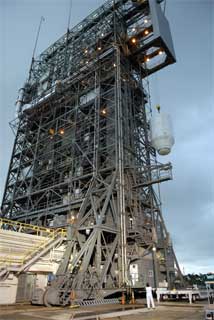 |
| Attached to an overhead crane, the Phoenix spacecraft is lifted alongside the service tower of Launch Pad 17A at Cape Canaveral Air Force Station in Florida. (NASA/George Shelton) |
The countdown clock is really ticking now É CanadaÕs space-bound weather station is scheduled to blast off Saturday, Aug. 3 at 6:26:31 a.m., on the NASA Phoenix Mission to Mars.
ÒNow everything comes down to that 15 seconds,” says Dr. Tom Duck, co-investigator for the weather station and associate professor in DalhousieÕs Department of Physics and Atmospheric Science.
ÒWe really need the launch to go well. And if we get through that OK, then thereÕs the landing, which is really complex and ambitious.”
He and research associate Cameron Dickinson will be on campus watching the liftoff happen live on NASA TV. The webcast will provide a variety of webcam angles on the Delta II rocket as it leaves Earth. Despite the groggy hour, theyÕll be joined by a number of media, as well as students and colleagues involved with DalÕs lidar research. The scientists are getting used to working at the crack of dawn, after an avalanche of recent national radio and TV media interest.
Tropical storms in Florida delayed the launch by a day Ð severe weather this week prevented the NASA launch team from finishing fueling of the rocketÕs second stage. But itÕs looking good to go for tomorrow, NASA's Launch Director Chuck Dovale said today at a Phoenix prelaunch news conference. Weather Officer Joel Tumbiolo reports favourable conditions for launch time, with only a 20 per cent chance of weather preventing liftoff.
|
Drs. Duck and Dickinson canÕt wait to see their four years of painstaking work finally embark on its 10-month journey, 680 million kilometres through outer space. TheyÕve been key players in providing scientific and design input to adapt lidar (Light Direction and Ranging) technology for the Canadian weather station.
The Phoenix lidar will be the first Canadian instrument to track daily weather on another planet Ñ it will measure dust in the Martian atmosphere, and hopefully find evidence of clouds and ice fog.
Now snugly aboard the Phoenix rocket, the new lidar equipment is just 6.8 kg, Òabout the size of a breadbox,” according to masterÕs student Lucy Crawford, of Carbonear, NL, who has been involved in DalÕs Phoenix effort. ThatÕs considerably smaller than the one on the roof of the Dunn building, which weighs several hundred kilograms and emits a green laser beam above the campus on clear nights. Another Dal lidar project is conducting climate change and pollution studies in the Canadian Arctic.
ÒTo be part of a Canadian mission on another planet, I canÕt even put that into words,” says Dr. Dickinson. ÒItÕs a first, so thereÕs extra pressure. We definitely feel that failing is just not an option.”
While the liftoff will be nerve-wracking, a bigger hurdle awaits in May 2008 when PhoenixÕs solar-powered lander descends on a previously untouched polar region. If it succeeds, Drs. Duck and Dickinson will join other Canadian scientists in Tucson, Arizona, where theyÕll use an array of satellites to remotely operate the lidar. The Phoenix Mars lander is also equipped with a robotic arm to dig through Martian soil and ice in the arctic region, and onboard scientific instruments will analyze the samples.
ÒItÕs just very exciting to do something at the very frontier of knowledge,” says Dr. Dickinson. ÒWeÕve gone to the depths of the earth, and weÕve done a pretty good job of exploring our own planet. This mission is going to push the frontier, certainly for space exploration and for science.”
See live coverage of the Phoenix launch on NASA TVÕs webcast at: www.nasa.gov/multimedia/nasatv/index.html.
Check out NASA's launch blog at: www.nasa.gov/mission_pages/phoenix/launch/blog.html.

